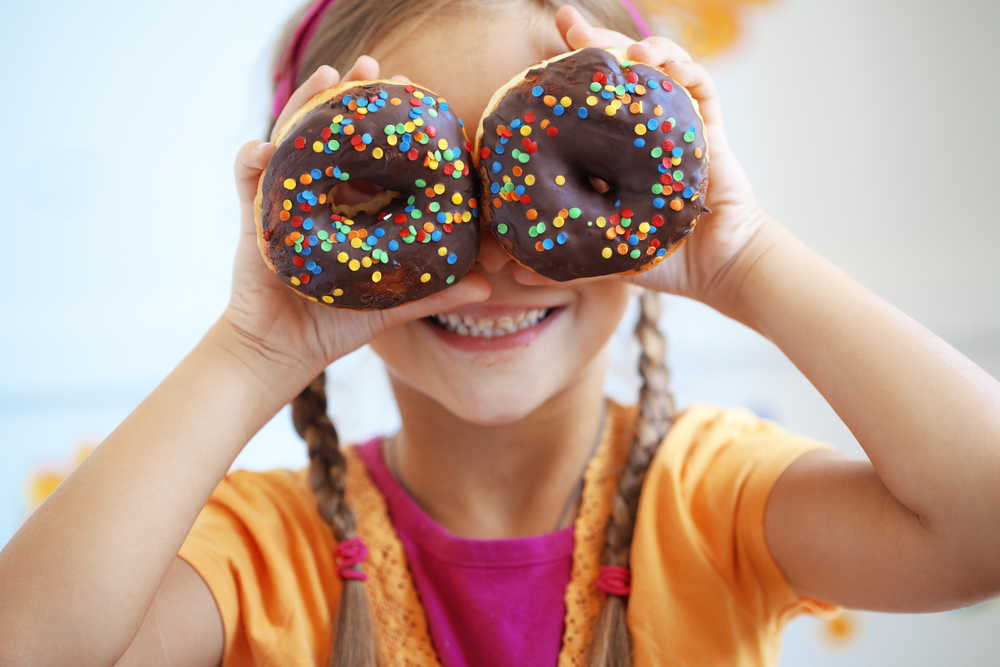
Sugar for toddlers: What is okay?
Do you want to know how much sugar is okay for toddlers to still be healthy, and know the sneaky places where sugar hides, beyond the obvious sugary treats?
How much sugar does the average toddler eat?
The most recent Dietary Guidelines for Americans (2020-2025) found that toddlers in the United States consume a lot of sugar! It’s an average of more than 100 daily calories from added sugars. The range is from 40 to 250 calories a day (about 2.5 to 16 teaspoons of sugar).
Sugar sweetened beverages (mostly fruit drinks) contribute more than 25 percent of total added sugars intakes. And sweet bakery products contribute about 15 percent.
It is okay for kids to have treats on occasion, but you want to be mindful of where their sugar is coming from, and how much they are getting.
Official dietary guidelines for sugar intake
Official guidelines from the American Heart Association state there should be NO added sugar in the first 2 years of life, and less than 25 grams (6 teaspoons) of added sugar per day for children over 2.
The reason these guidelines are in place? To prevent young kids from being at a higher risk for excess weight gain, high blood pressure, heart disease, and type 2 diabetes. Plus, excess sugar is not good for their teeth, either.
How many grams of sugar per day for a child?
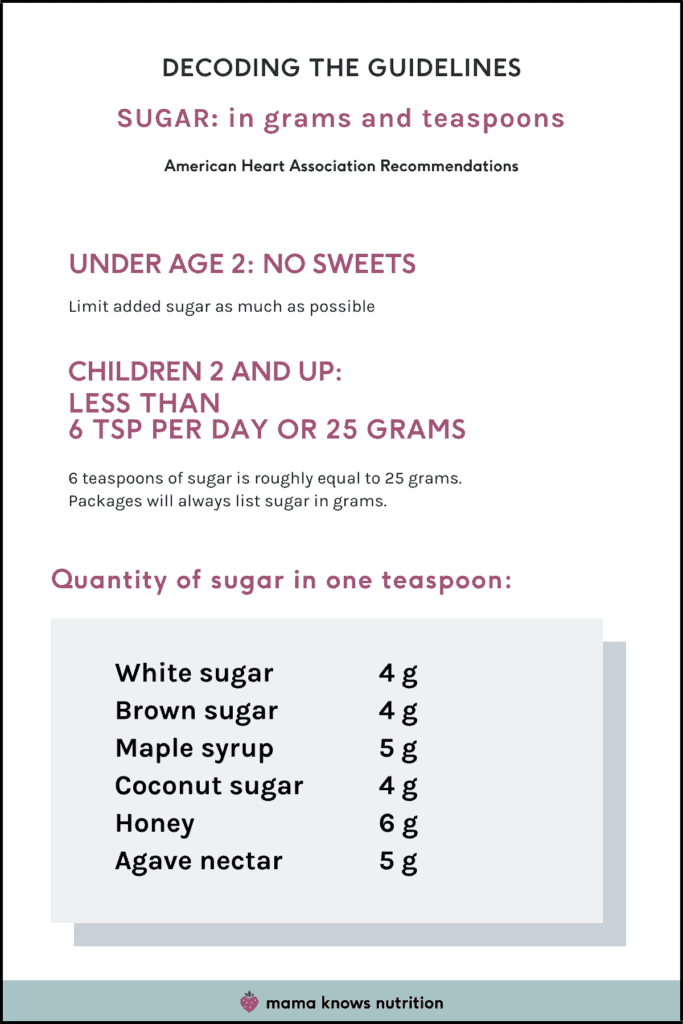
How to handle sugar for your toddler
This doesn’t mean you need to avoid ALL sugar. Just to clarify, toddler is about age 1 through 3. But, this info will apply to preschool and kindergarten kids too.
First, let’s cover the differences between added sugar and natural sugar.
Added sugar vs. natural sugar
Natural sugar:
The sugar that occurs naturally in fruit, cow’s milk, and breast milk has a green light.
These foods with natural sugars come along with many health benefits like vitamins and minerals, antioxidants, fiber, and more.
Do not feel like you need to limit fruit. Also that thing you heard about babies needing to have veggies BEFORE fruit, otherwise they won’t like veggies? Not true. That’s a myth.
You can introduce both fruits and veggies at the same time. Kids do tend to like fruit more and that’s OKAY.
Added sugar:
What are added sugars? ADDED sugar is primarily empty calories. This means it does not provide nutritional benefits.
And, too much can even prevent your little one from getting all the nutrients they do need from other foods, if they’re filling up on sugary drinks and sugary foods.
Maple syrup and honey DO fall into the “added sugar” category. However, I do prioritize them over granulated sugar. This is because they are less refined, and do have some health benefits.
For example, honey is shown to help a sore throat, and there are some trace minerals in honey and maple syrup. I also personally think they add more flavor than white sugar!
What does added sugar mean? Sugar is added for flavor, but it can also serve other purposes, too. It helps preserve foods (like jams and jellies), and can improve texture and color of baked goods.
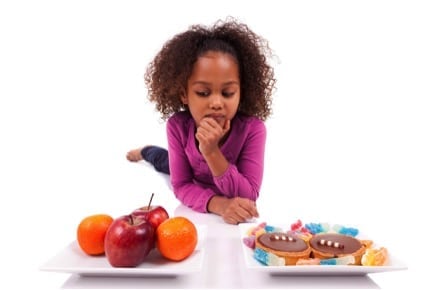
Reading nutrition facts for sugar
White sugar, brown sugar, corn syrup, raw sugar, coconut sugar, rice syrup. These are all added sugars. And that’s not even the full list!
You’ll find added sugar under these names:
- agave
- brown sugar
- cane juice
- cane sugar
- coconut sugar
- confectioner’s powdered sugar
- corn syrup
- corn syrup solids
- dextrose
- fructose
- fruit juice concentrate
- fruit nectar
- glucose
- high-fructose corn syrup (HFCS)
- honey
- invert sugar
- lactose
- malt syrup
- maltose
- maple syrup
- molasses
- nectars (e.g., peach nectar, pear nectar)
- pancake syrup
- raw sugar
- sucrose
- sugar
- white granulated sugar
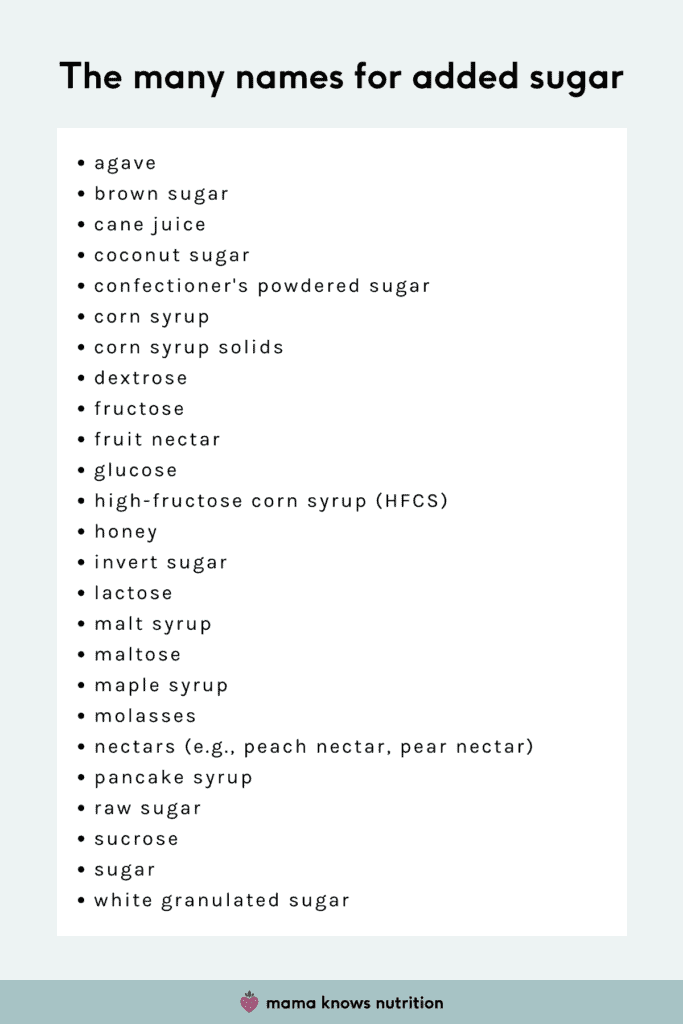
How to choose low sugar snacks for toddlers
If you see any of these names for sugar in the first 2 to 3 ingredients on the package’s ingredients list, it likely is high in added sugar. Check the nutrition facts on food labels. You’re ideally looking for snacks with under 6g added sugar per serving.
Most products list out the total sugar and the added sugar. The total sugar is equal to the naturally occurring sugar (from fruit or milk) plus the added sugar.
So I typically look at the “added sugar” row and make sure that it is around 6g or less.
Foods you wouldn’t expect to be high in sugar
I’m going to tell you a few SNEAKY places where you’ll find added sugar that you can limit for your toddler.
List of hidden sugars in foods
- YOGURT- the naturally occuring sugar in yogurt is OK. But MOST flavored yogurts have a significant amount of sugar added. Stick to plain yogurt or sweeten with fruit.
- BREAD- bread can be surprisingly high in added sugar. Check the label and look for one that has about 2g added sugar or less per slice.
- Granola bars and breakfast cereals: even ones marketed specifically to baby or toddler often have more than a teaspoon or two of sugar added.
In general, if you keep the packaged items to just once or twice per day, you should be easily able to stay within the 25 gram daily limit.
Effects of sugar on toddlers
Is it best to avoid added sugar completely?
For both babies and toddlers it is IMPOSSIBLE and UNNECESSARY to try to avoid added sugars completely. For example, there is added sugar in infant formula. That doesn’t mean that you should avoid it!
With added sugar in food, nothing bad will happen when they get a gram or two here and there from bread, or cereal, or a sauce you made. While you do want to 100% avoid honey for infants under 12 months, that’s the only type of sugar that NEEDS to be totally avoided at that time.
Some days your toddler will go over the 25g limit and you do NOT have to be tallying up every gram of sugar that they eat. A piece of birthday cake or a random cookie is a fun thing to enjoy, and that’s totally okay to do some days. Though they do recommend holding off until as close to 2 years old as possible.
When it’s your first child, you usually can avoid frequent treats for longer. They just don’t tend to be around them as much.
But with subsequent kids you’ll typically find that you’re at more parties, etc., where your younger one will be exposed AND will want to participate. That’s okay. When they’re under two, just give them a smaller portion, or do something like an empty ice cream cone, or plain yogurt with sprinkles, if they are feeling left out.
Food IS social and you don’t need to keep them from experiencing treats altogether. It’s part of celebrating, and that’s OKAY. With treats it’s about finding a balance, not complete avoidance. That’s not possible, and that sets them up to get obsessed or binge on sweets as they get older.
Sugar sweetened beverages
It is recommended to limit or avoid sugar sweetened beverages for children under 5 years of age. Sports drinks and soda pop are primarily just added sugar, and do not provide nutritional value. It’s a lot easier to overdo it on sugary drinks, so that’s why I wanted to add a special note of caution here.
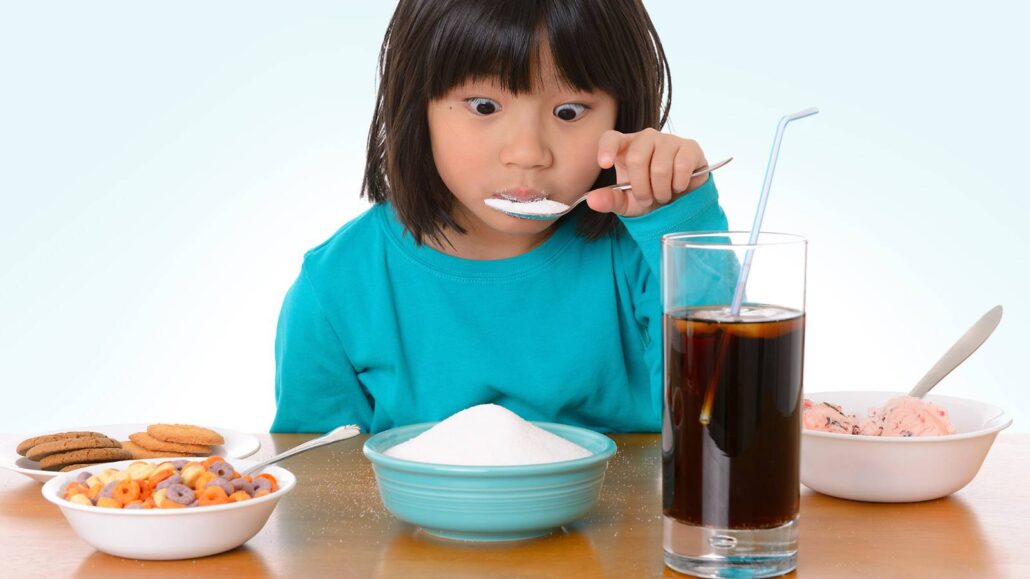

0 Comments